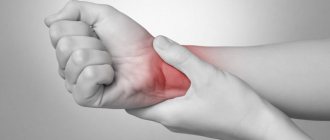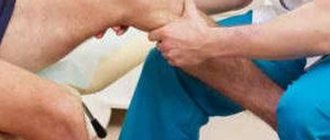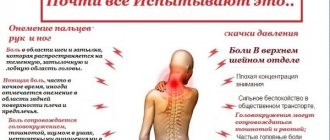Cubital tunnel syndrome (ulnar nerve compression syndrome) develops when the ulnar nerve is compressed in the cubital tunnel. Nerves are designed to carry impulses throughout the body, starting in the brain and spinal cord and ending in all organs of the human system. Due to the fact that the nervous system signals all changes in the body, being responsible for movement and sensitivity, a person can consult a doctor in time and prevent the development of many diseases. If the nerve is compressed, its full functioning will be impaired.
Anatomy
The ulnar nerve begins in the neck, where the roots exit the spinal region. These nerve roots emerge from openings in the spine. When they connect, three main nerves are formed, going down the arm to the hand. One of these nerves is called the ulnar nerve. It passes through the cubital canal, located behind the inner elbow. The nerve then descends along the forearm to the hand area. This channel is formed by a combination of muscles, ligaments and bone. If you straighten your arm and rub the hollow on the inside of the elbow, you can feel the cubital canal.
Due to the ulnar nerve, a person feels the sensitivity of the little finger, half of the ring finger, and can also control some muscles on the hand.
Diagnostic techniques
During the initial examination, the doctor must determine the level at which the ulnar nerve is being compressed.
The ability to make certain movements with the hand is determined, and the fingers are checked for sensitivity.
The presence of Tinnel's symptom is established (when tapping on the cubital canal intensifies the symptoms).
For the patient, a medical examination can be very unpleasant, but it is necessary for a correct diagnosis.
Basically, only an examination is enough to make a diagnosis.
If a particular case is in doubt, additional examination may be carried out. It is designed to identify an unusual cause of ulnar nerve compression syndrome.
For this purpose the following may be prescribed:
- Radiography . Designed to see bones;
- CT (computed tomography). Also intended to show bones, but with more detail;
- Ultrasound (ultrasound examination);
- MRI (magnetic resonance imaging). Designed to see soft tissue. These include muscles, cartilage, ligaments, etc.;
- EMNG (electromioneurography). A test that measures the speed of transmission of a nerve impulse.
Causes of the syndrome
The disease can develop for unknown reasons. It occurs differently in each patient. But usually the development of cubital tunnel syndrome is preceded by an injury in this department, or frequent and sudden movements of the hand, for example, during physical exercise. When the elbow joint is tense, compression of the nerve can occur, which occurs due to muscle tension. If you actively move this muscle, an inflammatory process will develop, the tendons will thicken, and the nerve will begin to hurt greatly.
Sometimes the disease develops due to prolonged pressure on the elbow, for example, when lying in one position, or when lifting a barbell. Another reason may be the habit of placing your hand on the car window in the door area.
The syndrome develops due to changes in anatomy in the cubital canal, which occurs due to the formation of bone spurs. This can happen in the following situations:
- with a fracture of the elbow;
- with a fracture of the shoulder joint;
- due to the formation of a cyst;
- when bone spurs appear;
- bruise in the elbow.
At-risk groups
Risk groups, which include certain professions and categories that are at risk of elbow tunnel syndrome.
People of certain professions
People whose professional activities involve constant flexion and extension movements of the arm.
The group includes professional tennis players, construction workers, violinists, and hairdressers.
Elderly age
Elderly people over 50 years of age, whose bodies undergo age-related changes.
Patients with concomitant diseases
At risk are patients with endocrine pathologies, due to which the body’s protective functions are weakened and structural changes in internal tissues occur.
This also includes the presence of autoimmune diseases.
You can also suffer from tunnel neuropathy of the ulnar nerve along a genetic line. People with hereditary pathologies such as arthritis or arthrosis are predisposed to the disease.
Symptoms
The earliest sign of cubital syndrome is numbness on the inside of the hand. The ring and little fingers also become numb. As cubital tunnel syndrome progresses, the numbness develops into pain. The arm may become numb due to prolonged periods in a bent position. For example, when a person talks on the phone for a long time, or while sleeping. There is clumsiness in the movements of the hand and thumb. This happens due to damage to the corresponding muscles.
If a push or blow is made to the area of the cubital canal, the person immediately feels pain or numbness in the little finger. This condition is medically called Tinel's symptom.
Symptoms of cubital tunnel syndrome are also called tennis elbow or median epicondylitis. In this condition, pain is felt in the area of the inner condyle of the elbow.
What is cubital tunnel syndrome?
It is believed that one of the most common causes of pinched ulnar nerve is repeated trauma.
Cubital tunnel syndrome is a disease that is accompanied by a pinched nerve. As a result, malfunctions in the functioning of the damaged department are observed.
The pathology is designated in the International Classification of Diseases (ICD-10) with code G56. The code shows mononeuropathies of the upper extremities.
Reasons for violation
A pinched nerve in the area of the cubital canal on the left or right can be caused by various reasons. Doctors cannot identify a specific factor that leads to pathology, since it develops differently in different patients.
In most cases, the cause of the disease is frequent injury to the elbow joint. Its damage can be caused by repeated repetition of flexion movements of the limb. This action can lead to an inflammatory process in the area of the tendon arch. Due to pathology, its size increases significantly. At the same time, the space of the cubital canal becomes noticeably narrower. Abnormal changes lead to compression of the nerve.
The constant influence of the negative factor discussed above contributes to the development of the syndrome. Typically, this reason explains the appearance of the disease in athletes and workers whose professional duties involve physical labor. Therefore, loaders, hairdressers and drivers often turn to doctors with such complaints.
Bad habits can contribute to the development of cubital tunnel syndrome. It is encountered by men and women who constantly support their head with their hand, while resting their elbow on a hard surface.
The risk group includes persons who have fractures of the upper limbs in the places where the cubital canal is located. Cysts and spurs are also unfavorable factors that lead to the disease.
Symptoms
If the initial symptoms of cubital tunnel syndrome do not go away within a few weeks, you should consult a doctor.
Compression of the nerve from which the elbow suffers can be recognized by the symptoms characteristic of this condition. As a result, a person develops a pain syndrome that cannot be ignored. Patients with this diagnosis also exhibit other symptoms:
- Numbness of the affected limb.
- Stiffness of movements.
- Increased pain when bending and straightening the fingers.
- Soreness in the elbow area.
Manifestations of the disease, that is, its symptoms, appear gradually. Over time they become more pronounced. Signs of a pinched nerve are felt most strongly in the morning, since during sleep the elbow is in a bent position for a long time. After this, the patient finds it difficult to write and type with the affected limb. Difficulties also arise in the process of holding any object.
The severity of painful symptoms decreases approximately 2-3 hours after waking up. If a person ignores treatment for the disease, then it becomes more severe.
It is strongly recommended that people who experience symptoms characteristic of the syndrome for more than a month seek medical help.
Complications and consequences
The lack of timely treatment results in the development of serious complications for a person. Due to the progression of cubital tunnel syndrome, the patient may experience partial paralysis of the upper limb. The pathological condition significantly limits his ability to work.
The late stage of the disease is characterized by the development of atrophy of the muscle tissue of the hand along with retraction of the interosseous spaces.
Not all patients manage to cope with the disease. In advanced cases, therapy does not help them. Therefore, people have to change their work activities. Patients may also be at risk of disability.
Complications and consequences
If treatment for cubital tunnel syndrome is not started on time, complications will develop in the future. The most common of them is partial paralysis of the arm and subsequent loss of its ability to work.
As the disease progresses, atrophy of the muscle tissue of the hand appears with the spaces between the bones receding.
After the first symptoms of the disease appear, treatment must begin immediately. If therapy is started after 3-4 months, then all measures taken by doctors will not bring the desired effect. Often such people have to change their professional activities, or even register for 3rd degree disability.
Diagnostics
If cubital tunnel syndrome is suspected, the doctor should initially examine the patient and listen to his complaints.
- By pressing on the elbow, the doctor identifies the level of nerve compression.
- Testing is done to ensure that the sensitivity of the fingers and motor abilities of the hand are preserved.
- The presence of cubital tunnel syndrome is detected, when a person feels pain when tapping on the elbow bend. This is a mandatory diagnostic measure.
All these actions on the part of the doctor are called palpation. This procedure can be painful as the doctor needs to identify the affected area in the area of the nerve endings. The patient will have to be patient, because this procedure is an important part of diagnostic procedures.
More about the procedure
Causes of Carpal Tunnel Syndrome
Ulnar neuropathy occurs due to pressure on the ulnar nerve. Common causes of this disease are the following factors:
- systematic support on the elbow on a hard surface;
- the elbow joint is in a bent position for a long time;
- abnormal bone growth;
- heavy or frequent physical activity;
- a profession in which the joint is under constant load (working on a computer, telephone, etc.);
- injuries.
Diagnostics
Typically, a history and a thorough physical examination are sufficient to suspect ulnar tunnel syndrome. Treatment largely depends on the stage of development of the disease and the cause of its occurrence, which can be determined during the diagnostic process. For this purpose, the following methods are used:
- Electroneuromyography is a study that gives the doctor the opportunity to evaluate the work of the muscles of the forearm and hand, determine the speed of impulse transmission along the nerve - the degree of conduction disturbance (nerve function).
- X-ray, ultrasound, MRI are also used in the diagnostic process, especially if there is a suspicion of injury, fracture, arthritis, gout and other diseases.
Preparing for surgery
There are no special recommendations for preparing for surgery. On the morning of surgery, do not eat or drink anything. If you take medication regularly, take it with one sip of water.
Contraindications
- Diseases that prevent anesthesia (discussed during consultation with a doctor)
- Purulent-inflammatory diseases in the area of surgery
Features of the operation
The operation consists of freeing the nerve from compressing tissue. If there is excessive mobility of the nerve, it is moved, covered with muscles so that it does not stretch when the arm is bent at the elbow joint.
Postoperative period
- After surgery, it is imperative to continue treatment with medications: painkillers; vitamins; decongestants; improving conductivity and nerve trophism.
- It is imperative to use medications in conjunction with physical therapy and physiotherapeutic methods. Only in this case will it be possible to achieve the effect in 3-6 months. In rare cases, with an advanced stage and severe muscle atrophy, complete restoration of sensory and motor functions is not possible, so it is very important to consult a specialist as soon as the first symptoms of the disease appear.
Treatment
If a person experiences discomfort only after squeezing the elbow, then conservative treatment is carried out. The load on the cubital canal is reduced, including in the form of flexions in this section, which contributes to the rapid restoration of its function.
To completely eliminate the load, at night the arm is fixed in such a way that it does not bend at all at the elbow. For example, a bent or twisted towel is tied to the elbow with a bandage, which does not allow the arm to bend.
When working with a computer, you will also need to hold your elbow, and when driving a vehicle, straighten your arms as much as possible.
In order for the symptoms of the disease to disappear as quickly as possible, you will have to use external anti-inflammatory drugs. In this case, Voltaren gel helps well, which is applied to the affected area up to 3-4 times a day. Such drugs can relieve pain and swelling, which often causes the development of cubital tunnel syndrome.
NSAID drugs are an important treatment measure for cubital tunnel syndrome. If they do not help, your doctor may prescribe stronger corticosteroids. For example, a Hydrocortisone injection in combination with an anesthetic has a good effect.
Sometimes doctors prescribe vitamin B6 for quick recovery, but it is worth remembering that you cannot take it on your own. Only a doctor can determine the advisability of its use and the required dosage.
This conservative treatment can last up to a month. In some cases it may take longer. But if numbness in the elbow persists, then the doctor may decide on surgical intervention.
Treatment of the syndrome
The choice of treatment for cubital tunnel syndrome depends on the current condition of the patient and the severity of the pathological process.
Operational
If the patient has advanced the disease, then only surgery will help him cope with it. Radical treatment is resorted to if conservative methods do not give a positive result.
Surgery allows you to create conditions under which the affected nerve will not be compressed.
For cubital tunnel syndrome, the following types of operations are performed:
- Decompression (allows you to increase the space in the canal and free the nerve).
- Transposition of the nerve anteriorly (displacement of the affected nerve).
- Medial epicondylectomy (cutting a separate area of the epicondyle to free up space).
The doctor decides which radical treatment method to choose. The choice of surgery directly depends on the severity of the disease and the difficulty of combating it.
After surgery, the patient will need to undergo a medicinal course of treatment, which is based on painkillers and anti-inflammatory drugs. Massage is used as an auxiliary treatment.
Conservative
Paracetamol should be prescribed with caution to pregnant women and during lactation.
If a person with cubital tunnel syndrome contacts a specialist in a timely manner, he will be able to limit himself to conservative treatment. To cope with the disease, you must first change the load on the affected joint. You should try to straighten and bend it less to reduce the pressure on the pinched nerve.
The disease is usually treated with medication. Patients are prescribed drugs from the following groups:
- Anti-inflammatory drugs (Paracetamol, Ibuprofen).
- Preparations for the restoration of the myelin sheath (Glycine, Copaxone).
- Vitamin complexes (Neuromultivit, Milgamma).
Doctors advise combining drug therapy with massage. It helps relieve muscle tension in the affected area. In addition, gentle massaging improves blood circulation in the joint area.
If the patient's condition is satisfactory, he can begin to do special exercises that speed up recovery. They are recommended to be performed in a sitting position. In this case, your elbows must be kept at an angle of 90 degrees to the surface of the table or floor.
The exercise therapy complex for the treatment of cubital tunnel syndrome includes the following exercises:
- Alternately raising and lowering the fingers, making rotational movements.
- Compression of the phalanx of the fingers on the injured limb.
- Alternately moving your fingers to the side.
Exercises must be performed even when pain occurs. She will accompany the patient throughout the training.
Surgery
Surgery for cubital tunnel syndrome involves eliminating the causes of compression of the ulnar nerve. It is carried out in case of ineffectiveness of conservative therapy. So, if after drug treatment there is no improvement within a month, then you should wait up to three months. If no changes occur, then surgery is prescribed.
After the surgical intervention is performed, the patient will have to refrain from physical activity on this joint for a certain time.
Types of operations
In case of prolonged numbness, as well as in case of fractures, doctors perform an operation, which can be of two types:
- Simple decompression. Part of the thickened walls that compress the nerves is cleaned, and a dissection is made in the area of the tendon arch. The operation is not classified as complex, but its disadvantage is that the effect is unstable.
- Nerve transposition. During surgery, doctors try to move the pinched nerve out of the cubital canal slightly forward. It is moved into the space between the muscles and subcutaneous fat. This operation is called anterior subcutaneous transposition. Sometimes the nerve is moved deeper into the axillary part. In this case, the operation is called “anterior axillary transposition”.
Traditional treatment
Traditional medicine for cubital tunnel syndrome will be effective only in combination with drug therapy and compliance with the rules for handling the sore hand. In addition, grandmother’s methods of therapy help with pain and swelling, but they are not able to eradicate the causes of this condition.
Traditional therapy for cubital tunnel syndrome involves the use of rubbing and compresses.
- To relieve swelling, cabbage leaves, burdock leaves or horseradish leaves are often used. It is enough to tie the plant to the sore spot and leave it for a certain time.
- You can use a steep dough made from vinegar and red clay. A cake is formed from this mixture and applied to the elbow overnight. The procedure is repeated for 3 days.
- Bear fat, which is applied to the affected area, helps well with swelling and pain in the elbow. The course of treatment lasts 1 month.
- You can buy the Bischofite solution at the pharmacy; it is also used as a rub, compresses or baths. This is done every other day, 10-12 procedures are enough.
- Compresses can be used from an alcohol-honey composition; mustard rubbing is also recommended.
- To generally strengthen the body and relieve inflammation, decoctions are prepared based on medicinal herbs, such as chamomile, St. John's wort, oregano, fireweed, and raspberries. It is recommended to drink them throughout the day instead of tea.
Cost of osteopathy in Moscow
| Service name | Price according to the price list, rub. | Discounted price* until March 15, rub. |
| Initial appointment (examination, consultation) with an osteopathic doctor | 1 500 | 1 000*** |
| Manual therapy session (osteopathic correction), children (infants), 30 minutes | 6 000 | 5 700 |
| Manual therapy session (osteopathic correction, soft techniques), (55 minutes) | 10 000 | 9 500 |
* Discounts apply only to primary patients of the clinic. Discounts on individual procedures are available when paying for a course (from 9 procedures).
*** Promotion until 15.03 - when starting treatment (or purchasing herbal medicines) on the day of consultation - consultation is FREE
The administration of the clinic takes all measures to timely update the price list posted on the website, however, prices may differ from the actual ones. Please, in order to avoid possible misunderstandings, check the cost of services at the reception or in the contact center by phone +7 (Moscow) or (St. Petersburg), daily from 9 to 21 hours. The price list posted on the website is not a public offer. Medical services are provided on the basis of a contract. Bank cards VISA, MASTERCARD, MAESTRO, MIR are accepted for payment. Contactless payment by cards, Apple Pay and Google Pay is also available.











